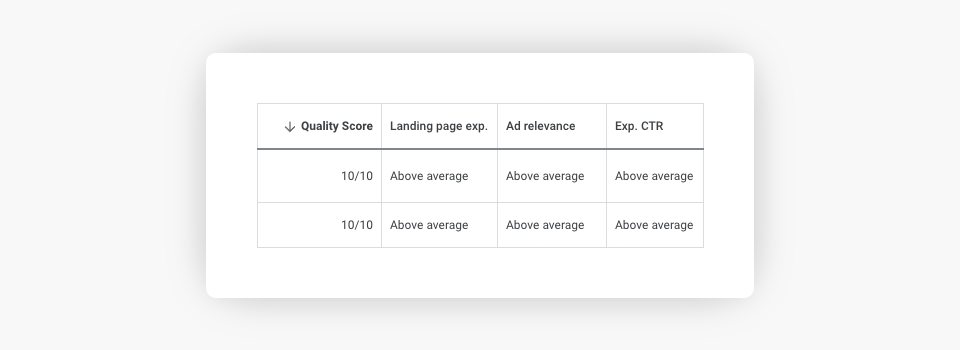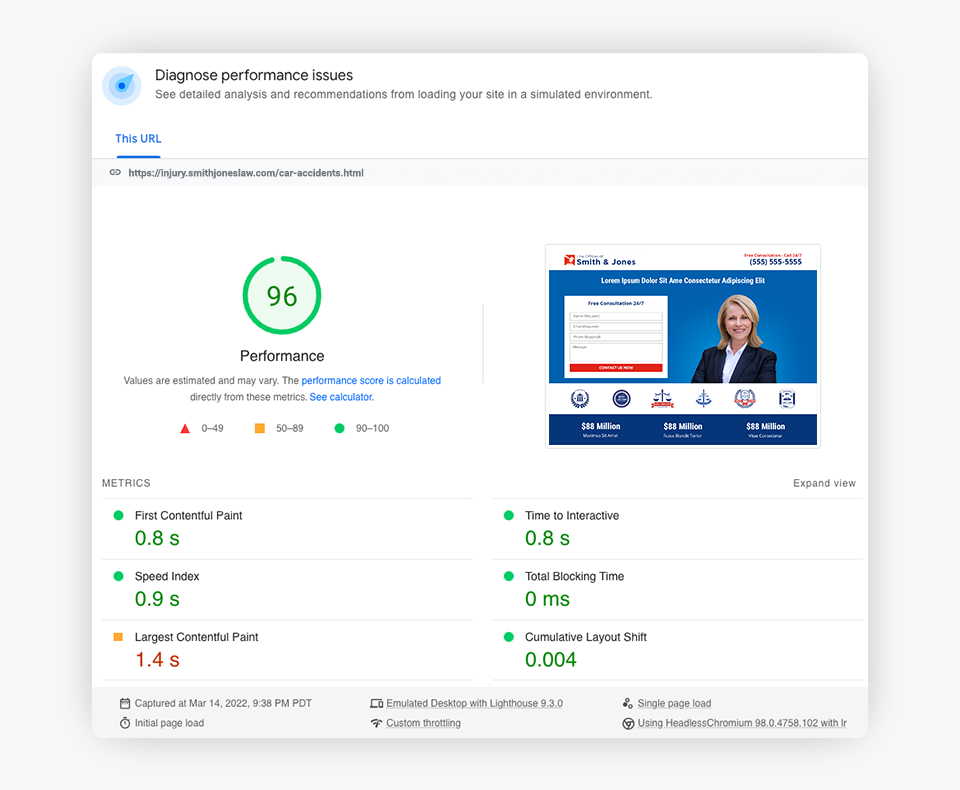We can’t send you updates from Justia Onward without your email.
Unsubscribe at any time.
Understanding your Google Ads Quality Score is an important part of increasing and evaluating the effectiveness of your Google Ads PPC campaigns. Read this post to learn more about why Quality Score matters to your law firm.
Pay-per-click (PPC) advertising continues to play an increasingly important role in effective search engine advertising year after year. Google, the most popular search engine in the world, has consistently increased the percentage of paid ads before the organic search results on its search engine results page (SERP). The increase in paid ads means that even if you are the top-ranked organic law firm website in your location and practice area, you are still likely to appear well down the page and even below the fold in some cases. This is one of the reasons why it’s important to implement a holistic marketing approach that utilizes both SEO and PPC.
Nevertheless, Google Ads PPC is key to maximizing your law firm’s visibility on the SERP. However, an effective PPC strategy is not as simple as bidding the most on your desired keywords to help your ad appear at the top of the SERP. Instead, your bid is just one of the many factors the Google Ads algorithm analyzes when determining which ads will appear at the top of the page.
Quality Score is one of the most frequently discussed (and most frequently misunderstood) aspects of the Google Ads process. Keep reading to learn more about what Quality Score is and why it matters to your law firm.
Watch this video for additional insights into Quality Score.
What Is Quality Score?

In Google’s own terms, Quality Score is a “diagnostic tool meant to give [advertisers] a sense of how well [their] ad quality compares to other advertisers.” However, it goes beyond just a comparison of your ad to other advertisers. Instead, Quality Score helps Google evaluate your campaigns to determine their quality and relevance to users’ particular search queries.
While your visible Quality Score is not an input for the Google Ads auction and is only a diagnostic tool to help you understand how to improve your ads, it historically correlates with ad performance. Quality Score has also been historically correlated with impacts on cost per click.
This Quality Score is calculated by considering a combination of your ads’ expected clickthrough rate (the likelihood that your ad will be clicked when shown on the SERP), relevance (how much your ad aligns with the searcher’s intent), and landing page experience (how useful and relevant your landing page is when searchers do click on your ad).
However, the Quality Score becomes even more complex when you take this discussion one step further. While Quality Score generally refers to a numerical rating of your ad performance, your auction-time Quality Score is a secret known only by Google and may not be the same as your visible Quality Score. This real-time Quality Score is not shared with advertisers, but considers numerous factors and is used in connection with ad rank.
This means that you have a Quality Score visible in your Google Ads account to help you understand your ad campaign performance that often correlates with ad performance and an unknown, dynamic real-time Quality Score that directly impacts your Google Ads campaign performance.
In a nutshell, Google uses real-time Quality Score (more detailed than the one you see in your Google Ads account) to evaluate how relevant your ad is to certain keywords you have selected and whether it will ultimately help Google searchers find what they are looking for. However, your visible Quality Score in your Google Ads account often correlates to ad performance and both your visible Quality Score and the real-time Quality Score are primarily measures of relevance and quality.
Why Does Quality Score Matter?
In the simplest of terms, your Quality Score correlates with the cost and effectiveness of your Google Ads campaigns. In the case of your real-time Quality Score, there is a direct connection between your score, campaign performance, and click costs.
Thinking of your Google Ads Quality Score in basic terms can indeed help you better understand your campaign performance. A low Quality Score is generally indicative of a disconnect between your ad campaign, your chosen keywords, landing page, and searchers. A high quality score generally means your campaigns are more likely to perform well and are equipped to better connect your firm with potential clients searching on Google. Your bid and Quality Score together ultimately are indicative of your ad rank and whether your ad will be served on the SERP.
Furthermore, your real-time Quality Score can impact whether your ads are eligible to enter the Google Ads auction, whether your ads are displayed on the SERP, how your ads are ranked, and the actual cost you pay for each click on your ad.
How Is Quality Score Calculated?
Because the Google concept of Quality Score is intended to increase user experience by showing more relevant ads to users each time they search on Google, algorithms primarily monitor user behavior. These algorithms use click data and other user behavior information to predict future behavior and determine how relevant your ads are to each searcher.
How Do I Improve My Quality Score?
Improving your Quality Score requires increasing the relevance of your Google Ads to searchers. The idea is that if you give searchers the information they are looking for, then your Quality Scores will improve, and your ad campaigns will perform better.
Tailor Ad Text

Therefore, you should take steps to make sure your ad text relates directly to your chosen keywords and common search terms. If you cannot tailor your ad text to relate strongly to your keywords, you may need to split the campaign into two groups that allow you to better target your desired keywords while increasing relevance.
Improve Clickthrough Rate

Improving your clickthrough rate (CTR) can also improve your ad quality score. Remember, Google has set up algorithms to monitor user behavior. Searchers frequently clicking on your ads signals the algorithm that your campaign is relevant to that search.
Thus, you can implement tactics designed to increase your CTR and, in turn, improve your Quality Score and expected CTR. This may mean editing your ad text to include a more compelling message, highlighting something unique or desirable (such as a free consultation or 24/7 availability), tweaking your call to action (CTA) to encourage more participation, or leveraging ad extensions differently.
Revisit Landing Pages

Tailor your landing pages to each of your Google Ads campaigns for ideal ad performance and improved Quality Scores. For instance, if someone is searching for a DUI attorney and your ad was for DUI representation, your landing page should be for DUI representation and not traffic ticket cases.
Your pages should also be user-friendly on any device size and are accessible for people with disabilities. You also want your pages to perform well from a technical perspective. Use tools like PageSpeed Insights to test your page’s loading time and be sure that your pages use responsive design.
Final Thoughts: Why Do You Care?
Your Google Ads PPC campaigns are only effectively helping your practice grow when they are shown to the right users at the right times. Therefore, you want to optimize your Quality Score to increase the likelihood that your ad is served in connection with relevant user searches.
However, effective optimization of PPC campaigns is complex and goes well beyond the surface of your Quality Score. If you need expert help in setting up PPC campaigns that do the most work for your firm, contact our legal marketing specialists today to discuss what Justia Amplify can do for you.
Related Posts